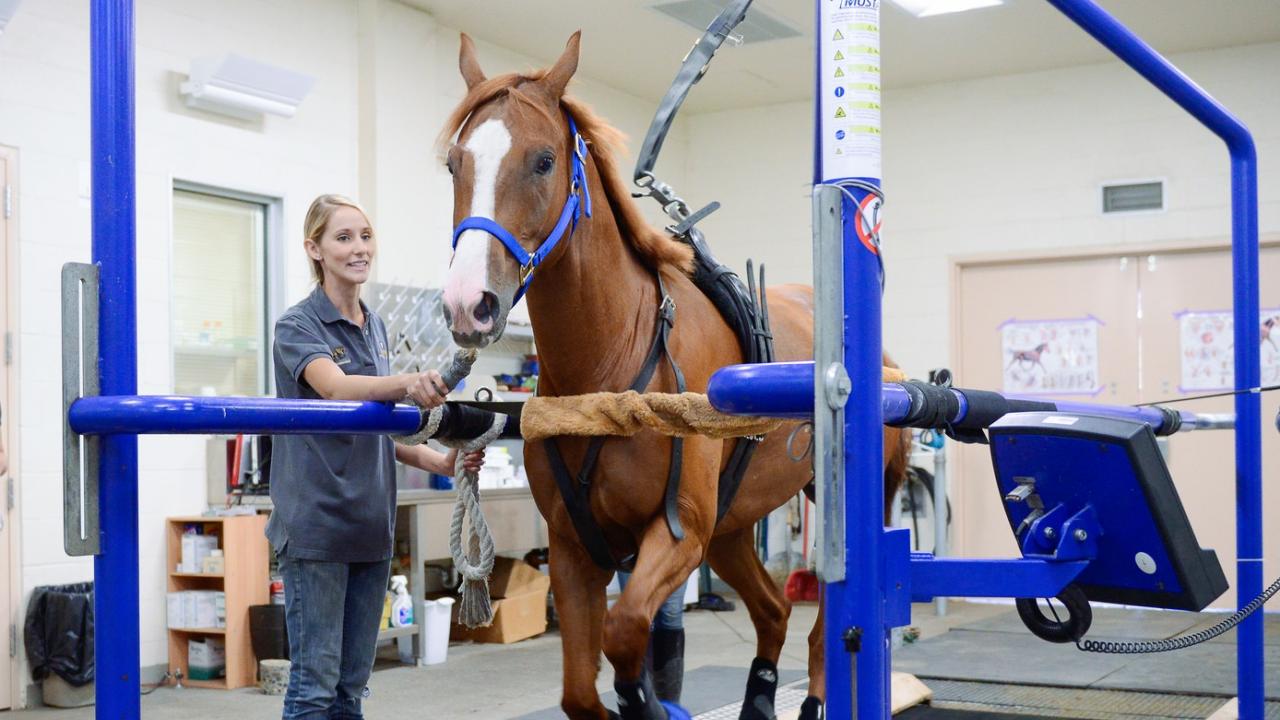
Improving Racing Safety
With the Triple Crown having been won twice in the past four years, horse racing is enjoying being in the spotlight. Consequently, drug testing and racing safety have also been brought to the forefront. At UC Davis, a group of horses are setting the standard for horse racing health and safety. Led by Dr. Heather Knych, a group of researchers with the Kenneth L. Maddy Equine Analytical Chemistry Laboratory are utilizing this herd to perform drug administration studies to determine how drug concentrations change over time in a horse’s system (pharmacokinetics) and the physiologic effects of the drugs (pharmacodynamics).
The herd of 16 horses (all former racehorses between 3 and 7 years of age) are exercised regularly at the Claire Giannini Hoffman Equine Athletic Performance Laboratory at the UC Davis School of Veterinary Medicine. After a substantial training period of safely acclimating the horses to running on a treadmill (and disqualifying the ones that never feel comfortable with it), the herd performs workouts to assist the researchers in their findings. These horses mimic the age, workout routine and fitness level of active athletes on the track to accurately correlate the resulting data to real-world racehorse applications. In addition to regular turnout exercise, they run for 20 minutes on the treadmill two days a week, and for 30 minutes in the Equicizer three days a week. While it is possible to reach 39 mph (Kentucky Derby speed) on the treadmill, the herd reaches about 29 mph. Safety is a priority for the team, and the horses are attached to a harness that not only triggers the treadmill to stop on a misstep, but also secures the horses from falling.
The overall goal of the research, with respect to racing, is to determine what drugs can be detected in a horse, and how long those drugs stay in a horse’s system. The results help develop analytical assays that become part of the routine drug screen of all racehorses.
On the veterinary side, knowing the pharmacokinetics helps veterinarians determine the appropriate timeframe in which legally prescribed drugs can be administered prior to racing, so the horse does not violate conditions for its next race. An example of this would be the use of furosemide to treat exercise induced pulmonary hemorrhage (EIPH). The diuretic drug decreases bleeding associated with EIPH, which is common in racehorses.
Furosemide is the only medication permitted for administration on race days in the United States. European racing does not permit any drug administration on race day, so there was a significant amount of international pressure to prove that furosemide can be effectively administered 24 hours prior to a race. UC Davis’ research on this subject was crucial in determining the benefits of administration timing to best protect horses with EIPH.
“With any studies we do, we also try to provide information that clinicians might be able to utilize in developing therapeutic plans for horses,” said Knych.
A major focus of the lab over the last several years is the study of intra-articular corticosteroids. Many horses with joint injuries temporarily benefit from injections of these anti-inflammatory steroids. However, the drug can also have detrimental effects, like breaking down cartilage. The lab’s studies have shown that even though the steroids are still present in joints, they cannot be detected in blood tests. Gene expression analysis showed the steroids are still active, even after they are no longer detectable in joints. The implication is that steroids do not need to be administered as frequently as previously thought and possibly at lower doses. This information should improve joint management in all performance horses.
The lab also plays an important role in monitoring banned substances. When several Russian athletes (including tennis champion Maria Sharapova) tested positive for meldonium in 2016, the horse racing industry was concerned that its use may move from humans to horses. The drug, which increases oxygen carrying capacity, and consequently improves athletic performance, had never been tested for in animals, so the lab worked with the top human drug testing lab in Germany to develop an equine-specific test. The results revealed that the drug can stay in a horse’s system for more than 60 days.
Another commonly abused banned substance in horse racing is cobalt, a mineral found in vitamin B. All horses have small amounts of cobalt in their systems, but elevated levels are purported to increase a horse’s oxygen carrying capacity, as the substance was at one time used as a treatment for anemia in humans before better treatments became available. The lab performed an administration study to develop an analytical assay that was sensitive enough to identify abnormal levels and to determine potential effects of the drug.
Both research and herd support rely on a variety of funding sources. The California Horse Racing Board provides primary funding for herd support, with the Center for Equine Health (CEH) providing supplementary funding and contributing to research projects. The Grayson Jockey Club funded the EIPH studies, contributed to the corticosteroid research, and continues to be a valued partner. Grants from the Racing Medication and Testing Consortium and from various breed organizations such as the American Quarter Horse Association also help fund the program.
In addition to this research, the lab can also perform in-depth investigations of respiratory, cardiac, musculoskeletal, and metabolic causes of poor performance and exercise intolerance.
The herd of horses is the only one of its size in the United States that is exercised regularly. Horses will generally rotate out of the herd at 7 years of age. Some become members of the CEH teaching herd, while most find new homes through the CEH adoption program (see page 7 of the Fall 2017 Horse Report). Others serve the UC Davis veterinary hospital’s Equine Reproduction Service as embryo recipient mares to assist clients wishing to explore alternative breeding options. Wherever their destination, the school goes to great lengths to ensure a safe and healthy future for these important members of the research team.
